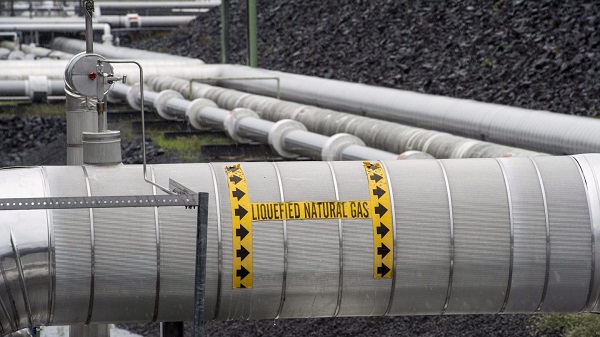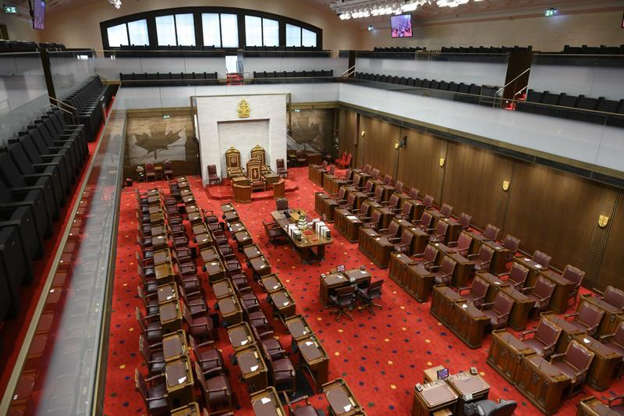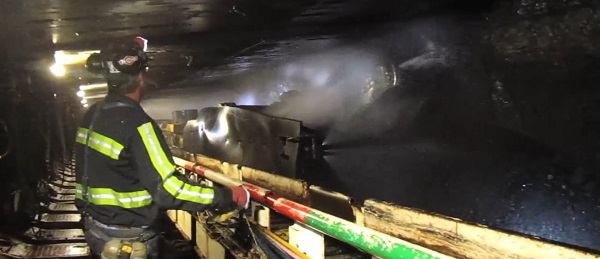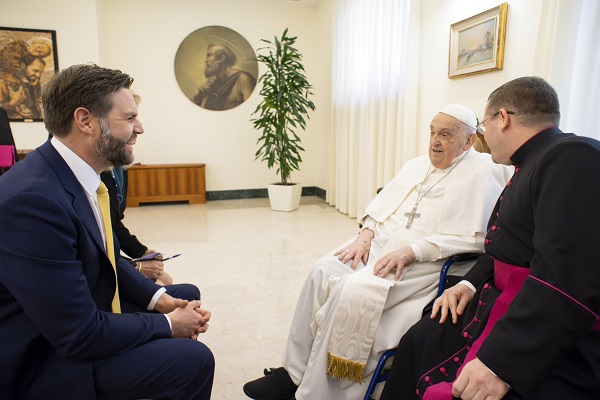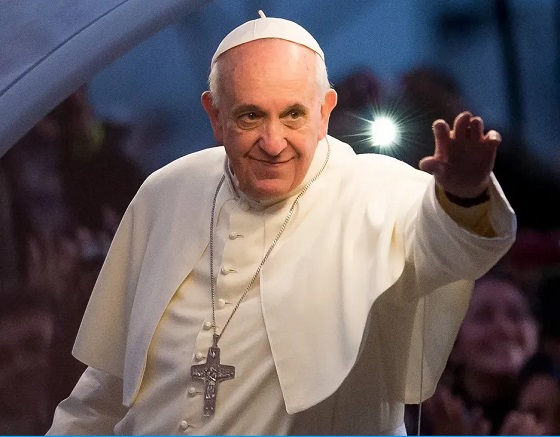The event was noted briefly in the legacy and Indigenous media, then disappeared. And in some ways, it was minor news. Yet another apology from a mainstream church over its role in the now-reviled Indian Residential School system. We’ve seen all that before. It would be a mistake, however, to dismiss this latest event as mere ecclesiastical virtue-signalling.
 On Easter Sunday, a “Sacred Covenant” was signed between the Tk’emlúps te Secwépemc First Nation of Kamloops, the Roman Catholic Archdiocese of Vancouver and the Diocese of Kamloops to mark their “mutual acknowledgment of past wrongs” and “a shared commitment to truth, reconciliation, and the future”. (Source of bottom photos: Tk’emlúps te Secwépemc, retrieved from (left) Victoria Now and (right) Castanet)
On Easter Sunday, a “Sacred Covenant” was signed between the Tk’emlúps te Secwépemc First Nation of Kamloops, the Roman Catholic Archdiocese of Vancouver and the Diocese of Kamloops to mark their “mutual acknowledgment of past wrongs” and “a shared commitment to truth, reconciliation, and the future”. (Source of bottom photos: Tk’emlúps te Secwépemc, retrieved from (left) Victoria Now and (right) Castanet)
Belying its limited media coverage, the Sacred Covenant should be seen as a significant and worrisome indicator of the continuing damage done by the explosive May 27, 2021 media release from the Kamloops Band that claimed “confirmation of the remains of 215 children” on the grounds of the former Indian Residential School located on the reserve. In fact, a closer look at the context of this unusual agreement reveals the many ways Canadian public discourse has been degraded by unsupported allegations of what many have called a genocide, and how this now threatens the very survival of the Church.
Three common features now appear in almost any discussion of Canada’s residential school legacy. First are incendiary accusations made by Indigenous groups about grotesque or murderous acts perpetrated on students who attended the schools. Second, secrecy and vagueness that frustrate critical review of the details or corroboration of the accusations. And finally, abject acceptance and ritual self-abasement by the accused – often the Government of Canada or a church organization – who appear unable or unwilling to defend themselves. The Sacred Covenant is one more example of the moral confusion and self-hatred now embedded in Canadian history. And within this mysterious document lie important lessons for all Canadians concerned about what reconciliation really means and where it is heading.
What We Know About the “Sacred Covenant”
The Kamloops Sacred Covenant was signed by Tk̓emlúps te Secwépemc Chief Rosanne Casimir, Vancouver Roman Catholic Archbishop J. Michael Miller and Kamloops Bishop Joseph Phuong Nguyen. It was followed by a native spiritual sunrise ceremony and Easter Sunday Mass with hymns sung in the Secwepemctsin language at St. Joseph’s Catholic Church on the Kamloops reserve attended by Indigenous leaders from around B.C. and the North.
The Sacred Covenant is one more example of the moral confusion and self-hatred now embedded into Canadian history.
According to a press release from Casimir, the agreement affirms “the dignity and rights of First Nations peoples [while also] repudiating past injustices.” The Covenant document itself reportedly “outlines practical commitments, including honouring and memorializing residential school students, facilitating access to historical records, and retaining scientific expertise to support the Nation’s efforts in uncovering the truth and promoting healing.”
In his formal statement, Miller clarified the difference between a covenant and lesser agreements. “A covenant…entails a profound and significant undertaking, not a trivial matter. In our case, the Sacred Covenant involves the honouring of your ancestors and the children who died or endured great suffering during their time in a Residential School.” He also accepted without question an obscure native interpretation of the 15th century papal “Doctrine of Discovery” that seems designed to undermine the entire concept of Canadian national sovereignty. Clearly it is meant as much more than a run-of-the-mill apology for past sins.
 “No trivial matter”: In addressing Tk̓emlúps te Secwépemc Chief Rosanne Casimir (left), Vancouver Archbishop J. Michael Miller (right) stressed the uniqueness of the Sacred Covenant as “a profound and significant undertaking…honouring your ancestors and the children who died or endured great suffering during their time in a Residential School.” (Sources of photos: (left) Ben Nelms/CBC; (right) The Catholic Register)
“No trivial matter”: In addressing Tk̓emlúps te Secwépemc Chief Rosanne Casimir (left), Vancouver Archbishop J. Michael Miller (right) stressed the uniqueness of the Sacred Covenant as “a profound and significant undertaking…honouring your ancestors and the children who died or endured great suffering during their time in a Residential School.” (Sources of photos: (left) Ben Nelms/CBC; (right) The Catholic Register)
The Kamloops Sacred Covenant, according to media reports, is the work of longtime Indigenous activists Phil Fontaine and Manny Jules. Fontaine played a central role in the creation of the broader narrative that residential schools were explicitly malign institutions with his explosive 1990 CBC interview in which he claimed that “every single one” of the approximately 20 boys in his grade 3 class had “experienced some aspect of sexual abuse.” Lost to time is that Fontaine’s recollection was about abuse perpetrated by his fellow students. Today, it is universally accepted that it occurred at the hands of school staff – especially priests and nuns.
Jules is a former Kamloops chief (now termed “Kukpi7”) and was chief of staff of the Assembly of First Nations when Fontaine was the AFN’s Grand Chief. Jules attended the reserve’s residential school as a grade 1-7 day student in 1959 to 1967 – the period when schoolchildren are now alleged to have died (or been murdered) and secretly buried beside the institution. In an interview on CBC’s The Current a week after the Kamloops Band announced “finding” the graves of 215 children, Jules claimed secret burials of students were common knowledge within his own family and “other residential school survivors.” Curiously enough, he never said anything about such outrages for nearly 50 years – not even when he was band chief nor when he testified before the Truth and Reconciliation Commission (TRC) in 2013.
 Phil Fontaine, former Grand Chief of the Assembly of First Nations, is reported to be one of the authors of the Sacred Covenant. He played a central role in initiating the broader narrative that residential schools were places of widespread abuse and horror. Shown at right, students and staff at St. Paul’s Indian Industrial School, Middlechurch, Manitoba, ca. 1901. (Sources of photos: (left) Ontario Chamber of Commerce, licensed under CC BY-ND 2.0; (right) Library and Archives Canada/PA-182251)
Phil Fontaine, former Grand Chief of the Assembly of First Nations, is reported to be one of the authors of the Sacred Covenant. He played a central role in initiating the broader narrative that residential schools were places of widespread abuse and horror. Shown at right, students and staff at St. Paul’s Indian Industrial School, Middlechurch, Manitoba, ca. 1901. (Sources of photos: (left) Ontario Chamber of Commerce, licensed under CC BY-ND 2.0; (right) Library and Archives Canada/PA-182251)
While we may know who is behind the Sacred Covenant and roughly how it came about, it remains unclear why it was done. Beyond a vague and somewhat ominous discussion of the Doctrine of Discovery, Casimir’s press release talks at length of the need to access church records and to make use of “scientific evidence” to ascertain the truth about the alleged graves. James Borkowski, Miller’s delegate for reconciliation efforts, similarly told The B.C. Catholic that, “What kept us progressing was a commitment to truth, wherever it takes us, and a desire to avoid divisiveness in this work.” Truth appears to be a major preoccupation of the Sacred Covenant. But if that’s the case, then why all the secrecy?
Sacred, or Merely Secret?
The Easter Sunday mass celebrating the covenant was restricted to selected invitees and was closed to the media. The text of the Sacred Covenant has also not been made public. Multiple requests to obtain a copy by this writer and other researchers have been rejected, as were requests from other legacy and Indigenous media outlets. The secrecy appears to be at the request of the Indigenous parties to the agreement, although church representatives say they hope to release it eventually. Beyond frustrating journalists, this reticence flies in the face of Christianity’s 2,000-year-long belief that God’s truth must be universally accessible. What would have been the point, for example, if Moses had come back from Mount Sinai with the Ten Commandments – but decided to keep them to himself?
 Why keep it a secret? The refusal to release the text of the Sacred Covenant runs contrary to Christian belief that God’s truth is universally accessible. Shown, Charlton Heston as Moses returning from Mount Sinai with the stone tablets listing the sacred Mosaic Covenant from the 1956 movie The Ten Commandments.
Why keep it a secret? The refusal to release the text of the Sacred Covenant runs contrary to Christian belief that God’s truth is universally accessible. Shown, Charlton Heston as Moses returning from Mount Sinai with the stone tablets listing the sacred Mosaic Covenant from the 1956 movie The Ten Commandments.
Secrecy and misdirection, however, are entirely consistent with current practice by Indigenous groups involved in the “missing children” and “unmarked graves” controversies. Regarding the May 27, 2021 media release, for example, each of the declarative words “confirmation”, “remains” and “children” were later revealed to be either false or unverified. That is because such claims were based on preliminary findings of a survey performed with ground-penetrating radar, which can only detect subsurface anomalies, and not what those anomalies might be. The Kamloops Band continues to withhold the actual survey report, as does the UBC academic who performed the work. More recently, the Kamloops Band has acknowledged the weakness of its original claims.
 A short-lived police investigation: While Kamloops RCMP under the direction of Chief Superintendent Sydney Lecky (top) began an investigation into the buried children allegations soon after the May 2021 press release, it came to an abrupt halt after Senator Murray Sinclair (bottom) complained the Mounties were “intimidating people, rather than helping them.” (Sources of photos: (top) Doug Herbert/CBC News; (bottom) Fred Chartrand/The Canadian Press)
A short-lived police investigation: While Kamloops RCMP under the direction of Chief Superintendent Sydney Lecky (top) began an investigation into the buried children allegations soon after the May 2021 press release, it came to an abrupt halt after Senator Murray Sinclair (bottom) complained the Mounties were “intimidating people, rather than helping them.” (Sources of photos: (top) Doug Herbert/CBC News; (bottom) Fred Chartrand/The Canadian Press)
We are still waiting for a coherent police investigation into what are alleged to have been horrific crimes. The RCMP began to investigate immediately after Casimir’s May 2021 press release – but equally quickly faced strident objections. Senator Murray Sinclair – former chair of the TRC – publicly accused the RCMP of “intimidating people, rather than helping them” and suggested the Mounties should restrict themselves to combing through documents.
The investigation was dropped within days of Sinclair’s complaints and turned over to the Kamloops band’s small Indigenous police service, who clearly lack the capacity for such a large-scale undertaking. Of note, the RCMP commander in Kamloops at the time, Chief Superintendent Sydney Lecky, is a member of the Peskotomuhkati First Nation of New Brunswick. He later transferred out of Kamloops and subsequently left the RCMP altogether; Lecky is now the Chief of Police in Timmins, Ontario.
And despite $7.9 million in federal funding to support investigative site work at Kamloops (plus another $12.5 million for a healing centre), there has never been any physical excavation of the alleged grave sites. Neither has there been any core-sampling, which is less intrusive but could still yield important information. In the few places elsewhere in Canada, where residential school site excavations have been attempted, no human remains have been found.
Keeping Records, Hidden
The signatories to the Sacred Covenant all claim the agreement is necessary to improve what is known about children who attended residential schools run by orders of the Catholic Church (over 40 percent of the residential schools were run by Protestant denominations and about 15 percent were run by the federal or territorial governments). There is, however, no apparent shortage of this information already available. Starting with the earliest transatlantic voyages, Catholic missionary orders generated many detailed records of their historical interaction with Indigenous peoples throughout the Americas.
Missionaries in what would eventually become Canada carefully recorded their firsthand knowledge of and interaction with Aboriginals over a period of five centuries in documents such as the Jesuit Relations. Beyond these readily accessible historical documents, the Catholic missionary orders that operated residential schools turned over all their unpublished school-related records to the TRC as part of the 2006 Indian Residential Schools Settlement Agreement, as did all other churches involved with the residential school system.
 Evidence aplenty: Since the time of first contact, Catholic missionary orders created ample records of their experiences with the Indigenous peoples of Canada; this later included detailed residential school attendance records. Depicted at left, Pere Marquette and the Indians, by Wilhelm Lamprecht, 1869; at right, a section of the original Samuel de Champlain monument in Orillia, Ontario. (Source of right photo: mahfrot, licensed under CC BY 2.0)
Evidence aplenty: Since the time of first contact, Catholic missionary orders created ample records of their experiences with the Indigenous peoples of Canada; this later included detailed residential school attendance records. Depicted at left, Pere Marquette and the Indians, by Wilhelm Lamprecht, 1869; at right, a section of the original Samuel de Champlain monument in Orillia, Ontario. (Source of right photo: mahfrot, licensed under CC BY 2.0)
Even more important and detailed are the voluminous federal and provincial government archives, especially those of the former Department of Indian Affairs. These contain a vast wealth of data including student applications for admission to residential schools, attendance records, letters, memoranda, investigations, medical information, birth and death certificates and numerous other details about the operation of the schools and their students. A small proportion of these records have been investigated by academics and journalists, including by C2C Journal, but the vast bulk remain largely unexplored. There are also a few private efforts dedicated to factual research in this area, including the Indian Residential School Records website, and the Indian Residential Schools Research Group, of which this author is a member.
 Truth-seekers keep out: According to Raymond Frogner, head archivist at the National Centre for Truth and Reconciliation, access to the millions of federal government documents held by his organization (and funded by Canadian taxpayers) pertaining to Indian Residential Schools and other Indigenous matters is restricted by the concept of “Indigenous Data Sovereignty”.
Truth-seekers keep out: According to Raymond Frogner, head archivist at the National Centre for Truth and Reconciliation, access to the millions of federal government documents held by his organization (and funded by Canadian taxpayers) pertaining to Indian Residential Schools and other Indigenous matters is restricted by the concept of “Indigenous Data Sovereignty”.
As part of the 2006 residential school settlement agreement, millions of federal government documents were turned over to the University of Manitoba under a trust deed signed in 2013 and are now held in the school’s National Centre for Truth and Reconciliation (NCTR). The goal was to create a single point of contact for all this important information. Unfortunately for anyone interested in searching for the truth, however, the NCTR does not offer unfettered access to non-Indigenous researchers.
As head archivist Raymond Frogner explained at an NCTR meeting in Yellowknife in 2023, access to these archives is limited by the concept of “Indigenous Data Sovereignty”. This refers to the alleged “right of Indigenous people to govern the collection, ownership and use of data about Indigenous communities.” In this way, anyone suspected of holding heterodox or opposing views about residential schools or native politics can be denied access to what were originally church or Government of Canada records (collected and archived at the Canadian taxpayers’ expense). This is contrary to the official mandate of the TRC.
The Polish-born pontiff readily admitted to the ‘faults and imperfection’ of his Church’s treatment of Aboriginal people. And yet his address brimmed with optimism and joy firmly supported by evidence going back to first contact between the Church and Canada’s Indigenous people.
In short, there is no scarcity of raw data concerning the operation of residential schools, who attended, and who might have passed away while attending such schools. What is lacking is transparent, convenient and guaranteed access to this information by anyone interested in seeing what it has to say. And the Sacred Covenant will do nothing to improve that.
How “Fraternal Love” Became the “Evils of Colonialism”
In September 1984, Pope John Paul II touched down at the airport in Yellowknife, kissed the ground and spoke to a small crowd before addressing the people of the North by radio. It was the first papal visit to Canada and the Polish-born pontiff readily admitted to the “faults and imperfection” of his Church’s treatment of Aboriginal people. And yet his address brimmed with optimism and joy firmly supported by evidence going back to first contact between the Church and Canada’s Indigenous people in the early 1600s. His words are worth recalling at length:
“I know of the gratitude that you yourselves, the Indian and Inuit peoples, have towards the missionaries who have lived and died among you…What they have done for you is spoken of by the whole Church; it is known by the entire world. These missionaries endeavoured to live your life, to be like you in order to serve you and to bring you the saving Gospel of Jesus Christ.”
“Whatever faults and imperfections they had, whatever mistakes were made, together with whatever harm involuntarily resulted, they are now at pains to repair. But next to this entry, filed in the memory of your history, is the record, with endless proofs, of their fraternal love.”
“That marvellous rebirth of your culture and traditions which you are experiencing today owes much to the pioneering and continuing efforts of missionaries in linguistics, ethnography and anthropology…Yes, dear Indians and Inuit, the missionaries have always shared in your cultural and social life.”
Pope John Paul II’s 1984 address triggered no political backlash. At the time, there was still general agreement among Indigenous people and the Canadian public that while the residential schools were both inadequately funded and poorly attended, they did more good than harm for those who persevered in their studies. Since then, however, the narrative has shifted dramatically – in large part because of Fontaine’s 1990 allegations. This change in opinion has infected not only the Indigenous political movement, academia and news media, but the Catholic Church as well.
Compare Pope John Paul II’s words to those of Pope Francis’s “penitential pilgrimage” to Canada in July 2022:
“…the suffering endured by Indigenous children, particularly those who, unfortunately, never came back from the residential schools…It is necessary to remember how the policies of assimilation and enfranchisement, which also included the residential school system, were devastating for the people of these lands. When the European colonists first arrived here, there was a great opportunity to bring about a fruitful encounter between cultures, traditions and forms of spirituality. Yet for the most part that did not happen…In the face of this deplorable evil, the Church kneels before God and implores his forgiveness for the sins of her children.”
 Inventing a new narrative: In his joyful and optimistic 1984 speech in Yellowknife, NWT, Pope John Paul II (top) paid homage to the “fraternal love” between Catholic missionaries and their native congregations. Four decades later, Pope Francis (bottom) denounced this relationship as “spiritual abuse”. (Sources of photos: (top) CP Photo/Fred Chartrand; (bottom) AP Photo/Gregorio Borgia)
Inventing a new narrative: In his joyful and optimistic 1984 speech in Yellowknife, NWT, Pope John Paul II (top) paid homage to the “fraternal love” between Catholic missionaries and their native congregations. Four decades later, Pope Francis (bottom) denounced this relationship as “spiritual abuse”. (Sources of photos: (top) CP Photo/Fred Chartrand; (bottom) AP Photo/Gregorio Borgia)
It is a papal statement full of self-recrimination and remorse. An accompanying Vatican News article added to this grim sense of self-flagellation, speaking of the “evils of colonialism” and the “attempt to erase the cultures of the indigenous peoples.” The change in tone and content is obvious. From the earlier pope’s unapologetic proclamation of Indigenous people embracing the Gospel of Jesus Christ to what should have been a “fruitful encounter” between (presumably equally valid and worthy) belief systems. From missionaries living as natives in “fraternal love” and providing the tools for their cultural rebirth to the “spiritual abuse” of children in the boarding schools and the “evil” of cultural (or worse) genocide. Pope Francis’s moral relativism – implying that the gospel of Jesus Christ has no higher standing than traditional Indigenous spirituality – effectively pulls the rug out from under the Roman Catholic Church’s 2,000-year-old mission of salvation.
An Argentinian who was formerly Archbishop of Buenos Aires, Pope Francis is a longtime self-professed sympathizer of Latin American “liberation theology”. Like Marxism (and now wokism), liberation theology regards the world as divided between oppressors and oppressed. In this instance, we have a simplistic binary between evil, exploitative Europeans and sacred, noble Indigenous people. It is a doctrine that eventually found its way to Canada and morphed into the current narrative of murderous white priests and nuns preying upon innocent Indigenous children.
In celebrating this progressive lurch to the woke left, Pope Francis also defamed the memory of the thousands of priests, nuns, lay brothers and lowly workers – many of them Indigenous – who gave a lifetime of work teaching and caring for tens of thousands of Indigenous children with the goal of preparing them to adapt to life in a rapidly changing Canadian society. Many of the nuns kept detailed records of daily events which were periodically forwarded to the mother houses of their religious orders, and paint a very different picture than the current narrative. It is true that Catholic missionaries were, by their calling, engaged in proselytizing. Their methods, however, were neither forcible nor absolutist; there were no forced conversions or baptisms.
 Claims of horrific abuse at residential schools defame the memory of the many Catholic priests and nuns who dedicated their lives to helping native children. Shown at left, Father Allan Noonan with students at the Kamloops Indian Residential School, B.C.; at right, a priest-coached baseball team at the Ermineskin Indian Residential School, Alberta.
Claims of horrific abuse at residential schools defame the memory of the many Catholic priests and nuns who dedicated their lives to helping native children. Shown at left, Father Allan Noonan with students at the Kamloops Indian Residential School, B.C.; at right, a priest-coached baseball team at the Ermineskin Indian Residential School, Alberta.
The Slow-Rolling Suicide of the Catholic Church
Despite its long history of selfless and often dangerous missionary work driven by an unswerving faith in the sanctity of its own beliefs, the Catholic Church today is mired in self-loathing and despair. In the wake of the Kamloops Band’s May 2021 press release, Miller was likely the first religious leader in Canada to apologize. “In light of the heartbreaking disclosure of the remains of 215 children,” he stated in a press release less than one week later, “I am writing to express my deep apology and profound condolences to the families and communities that have been devastated by this horrific news. Each time new evidence of a tragedy is revealed, or another victim comes forward, countless wounds are reopened.”
 No need to confirm, just grovel: The Catholic Church has repeatedly apologized for its participation in the residential school system, regardless of what the evidence says. Just days after the May 2021 announcement in Kamloops, Miller wrote to express his “profound condolences to the families and communities that have been devastated by this horrific news.” Shown, a memorial at the Centennial Flame on Parliament Hill, June 2021. (Source of photo: Bing Wen/Shutterstock)
No need to confirm, just grovel: The Catholic Church has repeatedly apologized for its participation in the residential school system, regardless of what the evidence says. Just days after the May 2021 announcement in Kamloops, Miller wrote to express his “profound condolences to the families and communities that have been devastated by this horrific news.” Shown, a memorial at the Centennial Flame on Parliament Hill, June 2021. (Source of photo: Bing Wen/Shutterstock)
Rather than withholding judgment until he saw actual evidence, Miller uncritically accepted the band’s entire array of incendiary assertions, damning not only the church but Canada as a whole. To repeat: to this day, no previously unknown human remains of any sort have been found in Kamloops or anywhere else.
Still, Miller and Borkowski are intent on going even further. Not only do they align themselves with the Indigenous narrative that residential schools were a “colonialist” policy amounting to a genocide, but they also agree with attempts to shut down any further debate on the matter. “Of course, we do not back up or support those who deny the tragic events in Kamloops and at residential schools,” Miller stated in March during another formal apology. (His third in total; he also apologized to the TRC in 2013.) “There’s no question that this was a tragedy in the past and those who claim that it wasn’t I think are certainly misplaced in their judgment.”
The Sacred Covenant thus continues the Catholic Church’s decades-long repudiation of itself and what was once its essential mission of spreading the word of Jesus. But how long can an inherently self-hating institution survive after adopting such a stance? If one accepts the narrative that residential schools were engaged in a scheme of murder perpetrated by nuns and priests acting on behalf of the organization’s broader leadership, then it stands to reason the Church itself must be considered a murderous and therefore irredeemable entity.
While most of Canada’s senior Catholic clerics appear willing to march along with this slow-rolling suicide, not all are onboard. In an interview last year with The Catholic Register following reports that the federal government was considering making it a crime to say that residential schools were not genocidal, Bishop Emeritus Fred Henry, formerly the Bishop of Calgary Diocese, explained that before apologizing it should be necessary to ascertain what exactly occurred. “Why,” Henry proposed, “is the Catholic Church not asking the federal government for proof that even one residential child is actually missing in the sense that his [or] her parents didn’t know what happened to their child at the time of the child’s death?” As Henry observed, it makes no sense to apologize for something that might never have occurred.
 A slow-rolling suicide. Among the few dissenting voices inside the Catholic Church is Bishop Emeritus Fred Henry, who warns of the long-term consequences of blindly accepting unverified claims that thousands of residential students “were murdered by Catholic priests and nuns and clandestinely buried in unmarked graves”. (Source of photo: Canadian Catholic News)
A slow-rolling suicide. Among the few dissenting voices inside the Catholic Church is Bishop Emeritus Fred Henry, who warns of the long-term consequences of blindly accepting unverified claims that thousands of residential students “were murdered by Catholic priests and nuns and clandestinely buried in unmarked graves”. (Source of photo: Canadian Catholic News)
‘Why,’ Henry proposed, ‘is the Catholic Church not asking the federal government for proof that even one residential child is actually missing…?’ As Henry observed, it makes no sense to apologize for something that might never have occurred.
The wholesale and unquestioning acceptance of the damning Indigenous narrative about residential schools will ultimately prove catastrophic for the Church, Henry predicted. “It seems abundantly clear to me [to ask what follows] if the Catholic Church…allows the lie that there are thousands of missing residential school children to become embedded in stone?” he wrote in the email interview. “Obviously, [it means] these thousands of missing children were murdered by Catholic priests and nuns and clandestinely buried in unmarked graves.”
Through its meek acceptance of Indigenous accusations and repeated apologies, the Church has thus manoeuvred itself into the position of being unable to mount a fact-based defence, even as the narrative becomes ever-more outrageous. The Sacred Covenant is yet another step in this process of self-abasement, another suicide note. As Henry worried, there is no apparent conclusion other than the complete destruction of the Church itself.
It is a process that is mirrored in the similarly self-flagellating behaviour of Canada’s governments and other secular institutions. The country is destroying its international reputation and eroding its feelings of self-worth because no one has the nerve to tell Indigenous leaders and activists that their residential school revisionist revolution has gone too far.
 Reconciliation or obliteration? Beyond the reputational damage suffered by the Catholic Church, widespread acceptance of the residential school genocide narrative undermines Canada’s international stature, distorts this country’s proud history and denigrates the many historical figures who worked for the benefit of future generations. (Sources of photos: (top) Colin Temple/Shutterstock; (bottom) Blake Elliott/Shutterstock)
Reconciliation or obliteration? Beyond the reputational damage suffered by the Catholic Church, widespread acceptance of the residential school genocide narrative undermines Canada’s international stature, distorts this country’s proud history and denigrates the many historical figures who worked for the benefit of future generations. (Sources of photos: (top) Colin Temple/Shutterstock; (bottom) Blake Elliott/Shutterstock)
According to a Maru Public Opinion online survey following the 2021 Kamloops claims, 55 percent of Canadians polled agreed that “given the context of the residential school era, what occurred was an act of genocide as opposed to an act of good intentions that had bad outcomes.” An astounding 81 percent said they agreed the International Criminal Court should investigate their own country for the worst of all imaginable crimes. To underline this point in bold, in 2022 the House of Commons unanimously voted to recognize “what happened in Canada’s Indian Residential Schools as genocide,” citing Pope Francis’s statements as evidence for such a conclusion.
Sweeping assertions about forced assimilation and physical genocide have grotesquely distorted the history of Canada’s relations with its Indigenous people, and defamed the many honourable historical figures who participated in the process. And there is no apparent corrective to this radical and destructive path. Indeed, as mentioned, the Liberal government has lately considered demands that it criminalize any contrary discussion of the entire issue, in essence outlawing any continuing search for truth.
All of which suggests that the end-point of the Sacred Covenant – and all other attempts by Canadian society to find common ground with an increasingly aggressive cadre of residential school activists – is not reconciliation. It is obliteration.
Hymie Rubenstein is a retired professor of anthropology who taught for many years at St. Paul’s College at the University of Manitoba, the only Catholic higher education institution in Manitoba. He is currently editor of the REAL Indigenous Report.
Source of main image: Steveleeart, licensed under CC BY-NC-ND 2.0.


